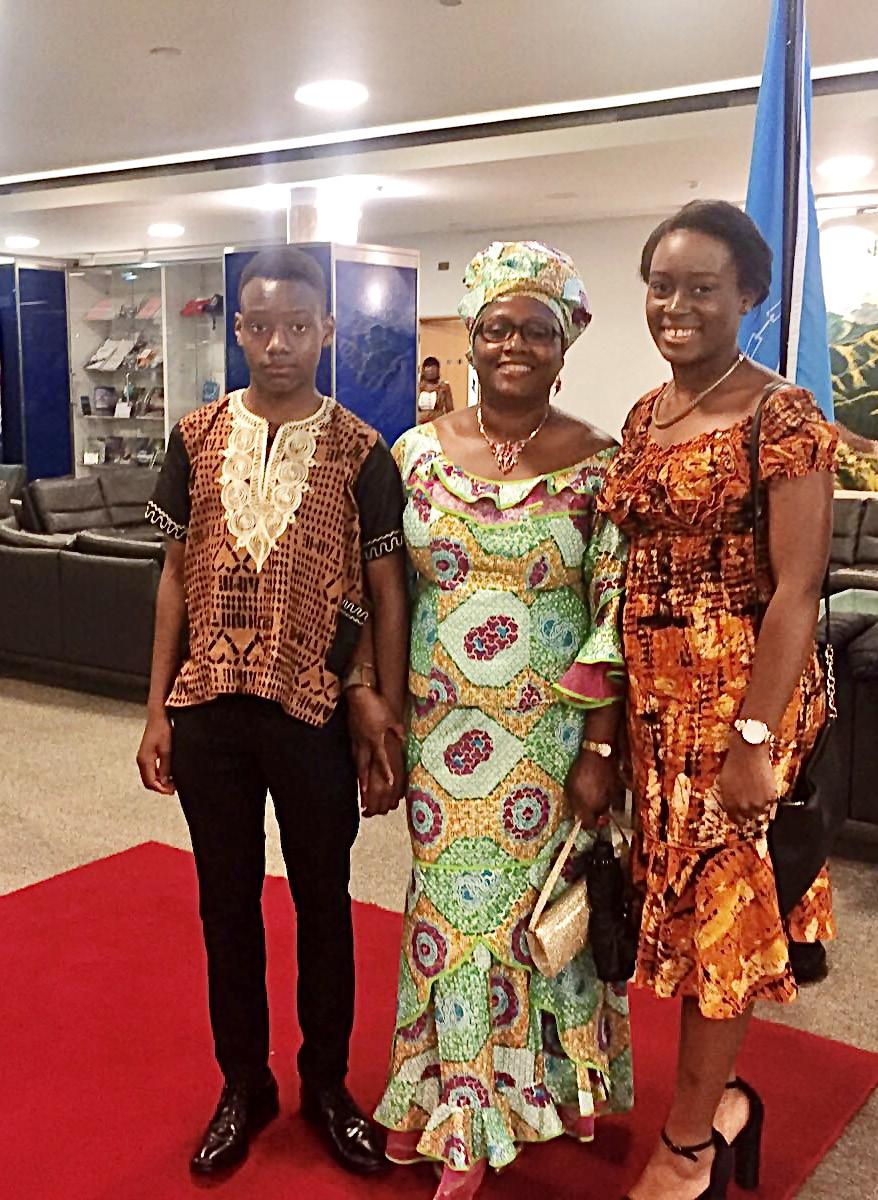
8 minute read
THE IMPORTANCE OF HOME
Due to the traumatic events encountered during the war, home quickly developed a whole new meaning, both psychologically and physically. The Cambridge Dictionary defines home as ‘someone’s or something’s place of origin, or the place where a person feels they belong’ (Cambridge University Press, n.d.). Johnston and Valentine (1995, p.162) describe the word home to have ‘multiple meanings’, referring to Somerville’s seven-point breakdown of the ‘concept’: ‘shelter, hearth (i.e., emotional and physical wellbeing), heart (loving and caring social relations), privacy, roots (source of identity and meaningfulness), abode and paradise (‘ideal home’ as distinct from everyday life).’ (Somerville, 1992, as cited in Johnston & Valentine, 1995). The Liberian civil war stripped civilians of their physical home, their ‘shelter’, ‘hearth’, ‘privacy’, ‘abode’, and for some, ‘paradise’ and ‘hearth’ as Somerville describes it, however due to the strong values of family, faith and togetherness rooted in Liberian culture and society, they still had their home in the form of their ‘heart’ and ‘roots’. Therefore, despite being displaced across the country, and later on the world, Liberians’ ‘heart’ and ‘roots’ is what allowed them to sustain a strong connection to their culture, family and physical home, even though in its current state, it may not be how they remember it to be.
In this study I have aimed to understand the way of life and significance of home in Liberian culture, and how this may have changed during the war. Up until this point, I have come to understand the structure, way of life, and relations within the communities, the responsibilities and roles of those living within the household, and how the war disrupted this. During my research I also asked my family members if they felt at home where they are currently living away from Liberia, if they still consider Liberia to be home, and also to define home in their own words after what they had experienced. This would enable me to gain further insight Into the importance of home and their perspective of home, how home differs now to the one that they remember in Liberia, and how they were able to find ‘home’ during a time of conflict.
Advertisement
When defining what home means to them, Estelle described home as her birth country, her birth town, the way in which they lived together and shared, their strong faith and similar ways of thinking which created a safe space of understanding (see Appendix B). Ortelius described home as ‘a place where you, your family and those you care about reside, where there is peace, a gathering of family members, and where loving memories have been built and created’ (see Appendix C). Serina and Franco described home as, ‘a resting place of refuge, safety, comfort, peace and stability’ (see Appendix F), ‘the place where you can make a living and feel comfortable’ (see Appendix D). When analysing these answers, it is evident that some recognise home to be a physical place and some recognise it as a feeling or emotion, which when compared to Somerville’s breakdown of the word home, led me to question whether home is a concept, a physical place, or both, and if so, what did this mean for individuals during and after the events of the war, as their physical home, and feeling of peace and comfort were taken from them.
Despite the destruction and the threat that the war brought to their home, many of my family members still perceived home as a place that was safe (see Appendix F) and where all their family gathered (see Appendix C), however, one could argue that this connection between home and feeling of security, even when their safety was at risk, could be formed from their memories of home prior to the war, (as they were able to leave their home before the rebels got to them). In The Memory Palace, Hollis (2013, p.14) explains that ‘the rooms we live in are collages, constructed conversations between the past and the present.’ Therefore, the ‘collages’ created within the rooms of their home in Liberia, would have consisted of only of past, happy memories that were created there, hence forming a
A glass shelving display unit in Estelle’s home, decorated with photographs, art, and ornaments.
positive memory of home that associates it with feeling of safety.
For Ortelius, who was living in the USSR away from his family during the war, he did not have the physical or the emotional and psychological connection to home, which in turn built up a lot of anxiety and tainted his perception of home at the time. Not physically being in Liberia and being unable to have any communication with his family or friends to know where they were displaced, or what happened to them, created a disconnect between him and his home. When Ortelius was finally able to return to Liberia after a few years to visit, going through his community and not knowing anyone or recognising any faces there, unlike before the war when he knew almost everyone in his community (see Appendix C), made it difficult to restore that physical connection with home again, however his memories and ties to Liberia through his family, upbringing and values are what enable him to still have that emotional and psychological connection, which subsequently allows him to still call Liberia home. This individual experience highlights the importance of home through the psychological and emotional aspects, as it shows that despite the physical place of home not being present, it is the psychological and emotional connection that allows people to preserve a relationship with their home.
From many, like Estelle and Franco, who moved from Liberia to other countries such as the UK, and US, it was difficult, especially coming from a different culture, climate, and society with different morals and values. Many felt that they were seen as inferior, or a minority, which led to them feel misunderstood, and therefore they were, unable to feel fully at home or be themselves in their new environments, as there was always a constant struggle to try and fit in or be accepted into the society (see Appendix B). However, individuals such as Henry and Serina, found it easy to adapt, as Henry quickly learnt the Dutch language, and Serina used the phrase, ‘home is where you hang your hat’ to describe her experience. She now considers her home in the US to be home and explained that she was able to leave a country that was dangerous and destroyed by the civil war, therefore she is grateful and thankful to God that she had the opportunity to create a home in the US where she can be at peace, live with her family and raise her children on the same morals and values that she herself grew up on as a child (see Appendix F).
Regardless of their different experiences adapting in a new country, they all had to find a way to adapt so that they could feel somewhat at home. Linking back to one of Somerville’s (1992, as cited in Johnston & Valentine, 1995) concepts of home, ‘roots’, and the pride that Liberians took in their homes, my family took what they had been taught as children about the upkeep of a household and began to implement this in their own homes to embrace their backgrounds and create a ‘source of identity and meaningfulness’ (Somerville, 1992, as cited in Johnston & Valentine, 1995). They were able to do this by raising their children (see Appendix F) on the same morals, values, and traditions that they were raised on, cooking traditional Liberian dishes, decorating their homes to represent and express their identity whilst also embracing their culture, and opening their homes up to share with those around them, as they did back in their communities. Sparke emphasises the importance of expressing of ones identity through the interior, as she explains that our understanding of modern interior should not be limited to only its aesthetic value, but that these spaces should also ‘emphasize its social, cultural, and psychological relationship with its users/inhabitants; its continuity with history’ and ‘the roles of both amateur homemakers and professional decorators interested in the interior as a site for (mostly feminine) self-expression and identity formation.’ (Sparke, 2010, p.14).
While Sparke’s statement suggests that homemakers are usually female, the practice of taking care of the home whilst growing up in Liberia was the responsibility of both the males and females of the household, therefore as Wise suggests, ‘the process of homemaking is a cultural one’, rather than a gender role, as ‘cultures are ways of territorializing, the ways one makes oneself at home’ (Wise, 2000, p. 394). This is evident in the way in which Liberians incorporate art, photographs, plants, souvenirs, ornaments and other types of déecor into the ‘homemaking’ of their interior
spaces, which can be seen in Figure 5 (see Appendix A), as these physical items create a cultural connection to one’s home and identity. Naturally, as humans ‘we daily recreate within our dwellings the intimate internal landscape of our fantasies’ as Troutman (1997, p. 359) suggests, and in this case the fantasies would be the fond memories of home life in Liberia; this, therefore, allows Liberians to express themselves freely, and feel comfortable in their own home away from home, whilst also sharing and enjoying their identity, culture, (refer to Figure 6), and space with others around them, a common value that was practiced within Liberian communities. In modern Liberian households today, a new form of the physical ‘home’ has been created to form a connection with the emotional and psychological concept of ‘home’.
Figure 6
Estelle and her children, wearing traditional dress at a Liberian Independence Day Celebration in London.





